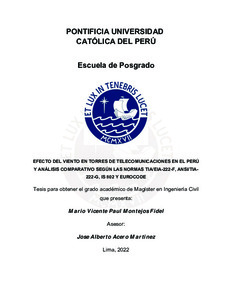| dc.contributor.advisor | Acero Martínez, José Alberto | |
| dc.contributor.author | Montejos Fidel, Mario Vicente Paul | |
| dc.date.accessioned | 2022-08-12T03:59:57Z | |
| dc.date.available | 2022-08-12T03:59:57Z | |
| dc.date.created | 2022 | |
| dc.date.issued | 2022-08-11 | |
| dc.identifier.uri | http://hdl.handle.net/20.500.12404/23061 | |
| dc.description.abstract | Hoy en día, el virus Sars-Cov2 en el Perú ha llevado que muchas personas trabajen y
estudien desde casa, creciendo la demanda en la cobertura de internet en sectores, como
educación, entidades públicas, banca, salud, etc. Estos cambios y la nueva tecnología 5G,
IoT (Internet of things) han llevado que la demanda de las construcciones de infraestructura
de telecomunicaciones crezca. La presente tesis busca estandarizar el análisis de diseño
de infraestructura de telecomunicaciones, investigar sobre los efectos de las antenas en la
población y realizar un análisis comparativo entre las normas americanas TIA/EIA-222-F,
ANSI/TIA-222-G, Indian Standard y European Standard, para torres de telecomunicaciones
autosoportadas en el Perú. El análisis se realiza según los siguientes parámetros: velocidad
de viento, área a la exposición del viento máxima y altura de torre.
Se estima que es posible acoplar las normas internacionales de diseño de estructuras de
telecomunicaciones a la realidad peruana. Además, en base a lo analizado se estima que
se puede realizar una estandarización de las torres autosoportadas según los
requerimientos solicitados.
El procedimiento usado consiste en realizar un análisis comparativo de torres
autosoportadas de 30m, 42m y 54m con base cuadrada de 1.00m, 4.00m y 4.07m,
respectivamente; “face panel” tipo DMH para 30m y 42m, y “face panel” tipo “XH” para 54m,
analizadas en 3 velocidades básicas de viento: 75, 90 y 110 km/h con una carga de antenas
de 03 APE4516R1v06, 03 RRU5502, 01 MW A23D06HAC y un EPA (effective projected
área) adicional, todas las antenas a tope de torre; el AEV (área de exposición al viento) total
asumido varía según la altura de la torre. Se consideran antenas tipo FLAT (planas) a
excepción de la antena MW que se considera tipo SHIELDED. Las estructuras están sujeta
a peso propio, carga muerta de equipos, escalerillas y feeders, carga viva y carga de viento.
El análisis se dará según las normas TIA/EIA 222-F, ANSI/TIA-222-G, Indian Standard y
European Standard.
La presente tesis demuestra la posibilidad de poder mejorar la norma peruana bajo los
estándares y cálculos usados en las normas internacionales según la realidad de región.
Las verificaciones y cálculos son variables respecto a cada norma y según las
características usadas. | es_ES |
| dc.description.abstract | Today, the Sars-Cov2 virus in Peru has led many people to work and study from home,
increasing demand for internet coverage in sectors, such as education, public entities,
banking, health, etc. These changes and the new 5G technology, IoT (Internet of things)
have led the demand for telecommunications infrastructure constructions to grow. This
thesis seeks to standardize the analysis of telecommunications infrastructure design,
investigate the effects of antennas on the population and perform a comparative analysis
between the American standards EIA-22F, 22G, Indian Standard and European Standard,
for self-supporting telecommunications towers in Peru. The analysis will be carried out
according to the following parameters: wind speed, maximum wind exposure área and tower
height.
It is estimated that it is possible to link the international standards for the design of
telecommunications structures to the Peruvian reality. In addition, based on what has been
analyzed, it is estimated that a standardization of the self-supporting towers can be carried
out according to the requested requirements.
The procedure used consists of carrying out a comparative analysis of self-supporting
towers of 30m, 42m and 54m with a square base of 1.00m, 4.00m and 4.07m, respectively;
DMH type face panel for 30m and 42m, and XH type face panel for 54m, analyzed in 3 basic
wind speeds: 75, 90 and 110 km/h with an antenna load of 03 APE4516R1v06, 03 RRU5502
, 01 MW A23D06HAC and an additional EPA (effective projected área), all antennas at the
top of the tower; the assumed total AEV (wind exposure área) varies according to the height
of the tower. FLAT type antennas are considered except for the MW antenna, which is
considered SHIELDED type. The structures are subject to their own weight, dead load of
equipment, ladders and feeders, live load, and wind load. The analysis will be given
according to the TIA/EIA 222-F, ANSI/TIA-222-G, Indian Standard and European Standard.
This thesis demonstrates the possibility of being able to improve the Peruvian norm under
the standards and calculations used in international norms according to the reality of the
region. The verifications and calculations are variable with respect to each standard and
according to the characteristics used. | es_ES |
| dc.language.iso | spa | es_ES |
| dc.publisher | Pontificia Universidad Católica del Perú | es_ES |
| dc.rights | info:eu-repo/semantics/closedAccess | es_ES |
| dc.subject | Sistemas de telecomunicación--Diseño y construcción | es_ES |
| dc.subject | Análisis estructural (Ingeniería) | es_ES |
| dc.subject | Diseño de estructuras | es_ES |
| dc.title | Efecto del viento en torres de telecomunicaciones en el Perú y análisis comparativo según las normas TIA/EIA-222-F, ANSI/TIA- 222-G, IS 802 y Eurocode | es_ES |
| dc.type | info:eu-repo/semantics/masterThesis | es_ES |
| thesis.degree.name | Maestro en Ingeniería Civil | es_ES |
| thesis.degree.level | Maestría | es_ES |
| thesis.degree.grantor | Pontificia Universidad Católica del Perú. Escuela de Posgrado. | es_ES |
| thesis.degree.discipline | Ingeniería Civil | es_ES |
| renati.advisor.dni | 29662895 | |
| renati.advisor.orcid | https://orcid.org/0000-0003-4154-9510 | es_ES |
| renati.author.dni | 46272097 | |
| renati.discipline | 732267 | es_ES |
| renati.juror | Rubiños Montenegro, Alvaro Cesar | es_ES |
| renati.juror | Acero Martinez, Jose Alberto | es_ES |
| renati.juror | Velasquez Vargas, Jose Martin | es_ES |
| renati.level | https://purl.org/pe-repo/renati/level#maestro | es_ES |
| renati.type | https://purl.org/pe-repo/renati/type#tesis | es_ES |
| dc.publisher.country | PE | es_ES |
| dc.subject.ocde | https://purl.org/pe-repo/ocde/ford#2.01.01 | es_ES |





